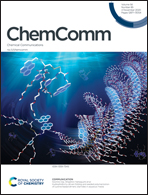Copper-catalyzed oxidative benzylic C(sp3)–H amination: direct synthesis of benzylic carbamates†
Abstract
A new efficient strategy to access benzylic carbamates through C–H activation is reported. The use of a catalytic amount of a Cu(I)/diimine ligand in combination with NFSI ((PhSO2)2NF) or F-TEDA-PF6 as oxidants and H2NCO2R as an amine source directly leads to the C–N bond formation at the benzylic position. The mild reaction conditions and the broad substrate scope make this transformation a useful method for the late-stage incorporation of a ubiquitous carbamate fragment onto hydrocarbons.



 Please wait while we load your content...
Please wait while we load your content...